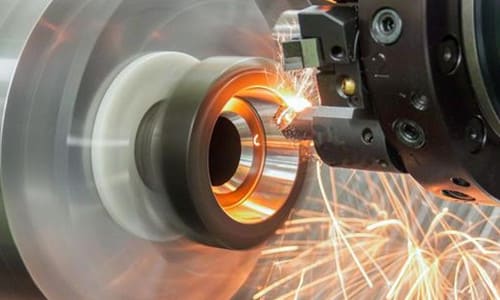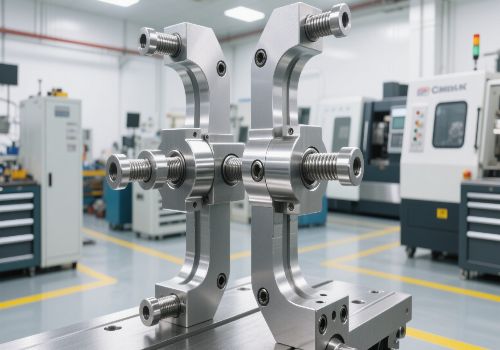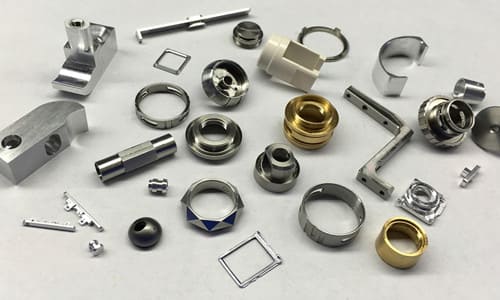With the continuous development of the manufacturing industry, the world’s machine tool manufacturers have been seeking to use new technologies to reduce the production cost of machined parts and finished products, making superhard cutting a new type of processing technology that manufacturers are currently concerned about. It is expected that in the near future, superhard cutting technology will develop more maturely and be widely used.
Superhard turning technology
Superhard turning is defined as a single-point cutting process for workpieces with high hardness materials above HRC 45. Generally, the hardness of workpiece material can reach the range of HRC 58-68, and the material of cutting tool is basically CBN (cubic boron nitride).
Superhard turning technology provides a new option for those machining and manufacturing that do not require ultra-high precision grinding. Of course, for some workpieces with ultra-high precision requirements, easily deformed workpieces and workpieces with special requirements, the grinding process is still a more suitable choice. Although superhard turning cannot completely replace ultra-high precision grinding at present, it can replace a considerable part of precision grinding, thereby reducing the expensive production cost in the grinding manufacturing process. At present, the surface roughness of superhard cutting workpieces can generally reach Ra0.2~Ra0.4, the roundness can reach 0.0005mm, and the dimensional accuracy can be controlled within 0.003mm. After cutting comparison, it is found that the production efficiency of superhard turning process is 4 to 6 times higher than that of general grinding process.
Stability of continuous machining
An important sign of turning superhard materials is to ensure the stability of continuous machining. This is related to the overall dynamic rigidity of the machine tool, the cutting tool, and the heat treatment state of the workpiece.
The use of polymer (artificial marble) to fill the main parts of the machine body to increase its damping coefficient (usually 8 times that of the cast iron bed), combined with the use of linear rolling guides, will have a huge impact on the turning process of superhard materials , greatly reduce the vibration caused by cutting, and increase the time for rapid return to static rigidity. The test results show that the improvement of the machine tool can effectively suppress the tool chipping caused by the vibration of the machine tool, prolong the service life of the tool, greatly improve the accuracy of the workpiece to be processed, reduce the dispersion of the tolerance zone, and improve the surface quality of the workpiece.
Another important factor is the performance and precision of the integration of the various moving axes of the machine tool, including the machine’s accuracy, geometric accuracy, electronic control functions, error compensation, and general adjustment and thermal deformation effects. This is because the final processing result of the workpiece is completely determined by the performance and accuracy of the machine tool.
Usually, ceramic cutters are used for rough turning, and the cutting depth is greater than 0.25mm; CBN cutters are used for fine turning, and the cutting depth is less than 0.25mm.
In order to achieve the ideal effect of turning superhard materials, it is also necessary to control the heat treatment state of the workpiece. Generally, the change in quenching hardness is required to be less than between two points of HRC. If the workpiece is a carburized part, it is necessary to ensure the consistency of the depth of the carburized layer. Generally, the depth should be controlled within 0.8 to 1.2 mm.
Advantages of superhard material turning
Compared with the grinding process, the turning of superhard materials has the following advantages:
- Both “soft cutting” and super-hard cutting can be performed on one lathe. One machine tool is equivalent to two machine tools, which not only saves the workshop space, but also reduces the capital investment in purchasing machine tools;
- The cutting efficiency of superhard turning is 4 to 6 times that of grinding;
- In the process of superhard turning, workpieces with complex shapes can be processed by the single-point cutting characteristics of the turning tool, while the grinding machine can only use the forming grinding wheel for grinding;
- One setting can complete multiple cutting processes, saving the time of workpiece handling and re-installation, and reducing workpiece damage;
- Superhard turning can easily reach the surface roughness of Ra0.2~Ra0.4;
- The superhard turning lathe can adapt to workpieces of different specifications. Especially in the mold industry, it can meet the processing of different batches and complex workpieces;
- The chips of superhard turning are easier to deal with than grinding chips, and meet the requirements of environmental protection;
- The tool inventory cost is low.
In conclusion
Superhard turning is a practical technology that can provide good economic benefits and better workpiece quality, especially on machine tools with high dynamic rigidity. The superhard turning process is not much different from the general turning process. Most manufacturers can introduce this new technology and apply it to actual production.
Looking forward to the future, with the continuous improvement of cutting technology and machine tool performance, the new technology of superhard turning will gradually become perfect and will be more widely used.
As a professional CNC machining manufacturer, DO Machining not only produce metal parts, but plastic and wood parts are also available.
Please visit our CAPABILITIES and what PRODUCTS we did.
CNC machining service is the core business of DO Machining, from protptyes to bulk production, our professional 3/4/5 aixs CNC machining centers, CNC turning equipments, CNC turning-milling equipments, CNC grinding machines etc., are operated by well trained manufacturing engineers to meet the demands from global 1000+ customers in 30+ industries.
CNC Machining can be done starting with blanks produced from standard bar stock or one of DO Machining other manufacturing processes.
Contact us to see how we can provide overall value to your CNC machining needs.











